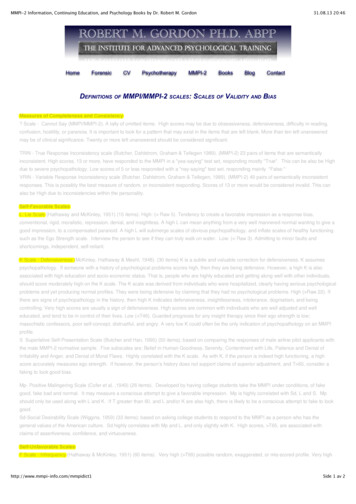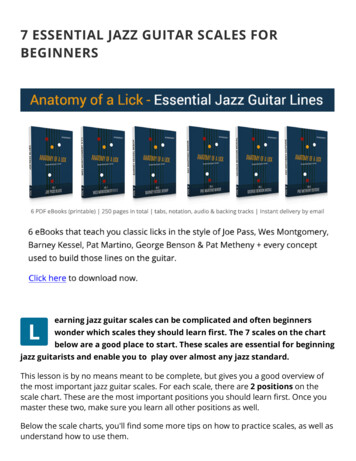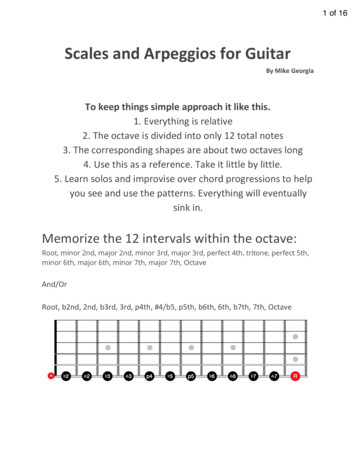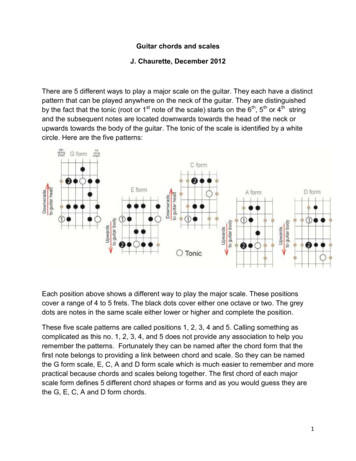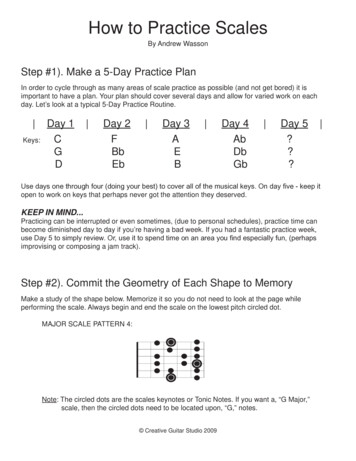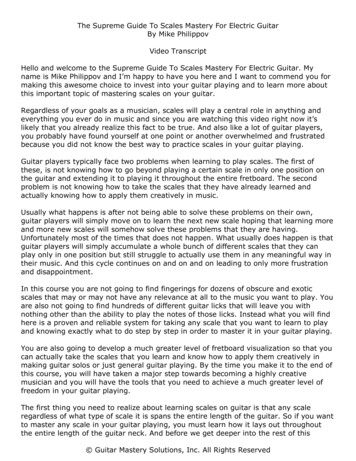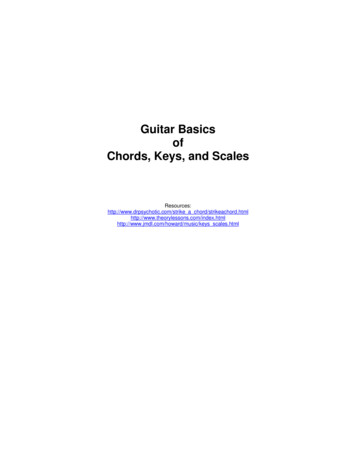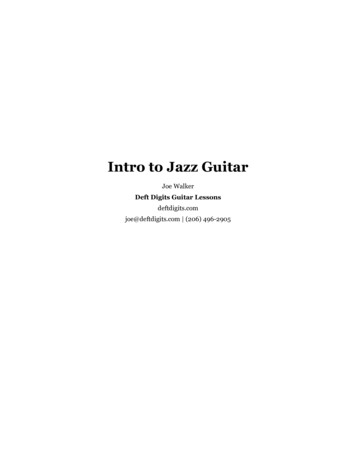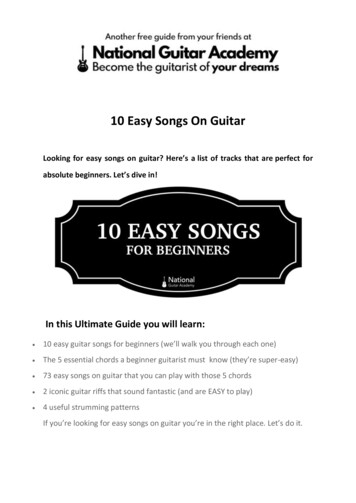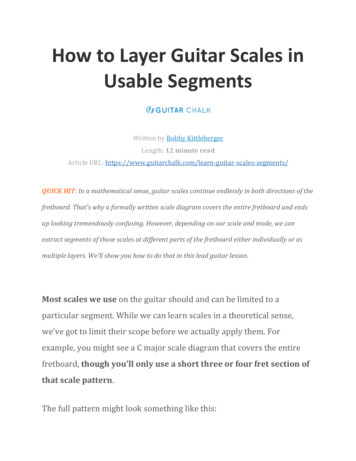
Transcription
How to Layer Guitar Scales inUsable SegmentsWritten by Bobby KittlebergerLength: 12 minute readArticle URL: gments/QUICK HIT: In a mathematical sense, guitar scales continue endlessly in both directions of thefretboard. That's why a formally written scale diagram covers the entire fretboard and endsup looking tremendously confusing. However, depending on our scale and mode, we canextract segments of those scales at different parts of the fretboard either individually or asmultiple layers. We'll show you how to do that in this lead guitar lesson.Most scales we use on the guitar should and can be limited to aparticular segment. While we can learn scales in a theoretical sense,we've got to limit their scope before we actually apply them. Forexample, you might see a C major scale diagram that covers the entirefretboard, though you'll only use a short three or four fret section ofthat scale pattern.The full pattern might look something like this:
A full scale pattern. Image via music.stackexchange.com(View LargerImage)This is because every scale interval pattern repeats itself and continuesendlessly in both directions.Any time you have a root note, the scale is the pattern thatcontinues until you get to the next root note an octave higher. Thus, tolearn the full form of a scale, you only technically need to memorize thenotes that occur within that octave. Yet a segment is not necessarily justthose notes which, in the case of a diatonic scale, includes only seven.Full Professional Guitar Lessons & SongTutorialsWant to learn some songs and put your guitar scales to work? GuitarTricks has a library of over 800 professional, full song tutorials shot
in crystal clear HD videoand 100 percent accurate licensed tab sheets.Here are just a few examples: "Perfect" by Ed Sheeran "Folsom Prison Blues" by Johnny Cash "Let it Be" by The Beatles (easy version) "About a Girl" by NirvanaUSE THE FREE TRIALGuitar Tricks will let you try their membership 14 days free, with an additional 60 daysafter that to cancel with a full refund.Checkout the FREE trialCHECK FOR A PROMO OFFERCheck to see if Guitar Tricks is running any kind of promotional offer, which often dropsthe yearly price to 99, which is regularly 249.Check for a PROMO offer
Learning to extract and use segments doesn't limit you to the steps in aoctave to octave scale, rather it allows you to do the following: Build continuous melody from the bottom register (low strings) to the higher register(top strings) Use portions of a scale that exceed the limitations of octaves, continuing in bothdirections Layer scales with other scales and modes to expand existing segmentsIf this language is foreign to you, I'll go through a detailed explanation ofthis process, meaning you don't have to get it all up front. Moreover,there's a much easier way to think about it: We're going to take usablepieces of scales and modify them.To aid in this process visually, I'm going to use the GuitarLayerssoftware, which I'd highly recommend downloading and using alongwith this material. It's a fantastic tool that I've just discovered and havebeen enjoying thoroughly. This is not a sponsored post and they're notpaying me to say this. I just legitimately really like it.
Setting Up Scales and GettingStartedTo start this exercise and illustrate the concept, I'll first setup a guitarscale in GuitarLayers so we have a working example. I've used the CDorian mode, though you can select a different scale if you'd like.When identifying a full scale, you only need to think about two variables:1. Key2. StructureIn my example, I've chosen a scale in the key of C with a Dorian structure.Pretty basic so far.Guitar Scale Segment #1 : The C Dorian Mode
In GuitarLayers I select the key of C and Dorian mode (structure) whichdisplays a full fretboard of scale notes made up of the seven notes in theDorian mode, since it is technically a diatonic scale. (View Larger Image)You can see at the top of the screen shot where the software gives youthe seven notes in the Dorian mode which are C, D, E , F, G, A and B .From there we can look for segments in the scale. If you aren't using thesoftware, just follow along with the next step.If you are using the software click on the button under "FretboardConstraints" and select "Vertical." This allows you to choose a fretsegment and map it in a vertical position, per the following screenshot:
Use the "Fretboard Constraints" option (or simply make a note if you're notusing the software) to map a segment of the C Dorian mode vertically, toactually use the shape. (View Larger Image)You can see that the shape now looks a lot more manageable, perhapseven more familiar and what you're used to seeing when you lookupguitar scales. Let's go ahead and drop that same shape into a tab sheet.
The same segment translated to tablature for easier reading. (View LargerImage)LAYERING THE DORIAN MODEAt this point in a scale-focused guitar lesson, you'll often hear talk aboutadding notes or slightly modifying the scale shape. It's true that you cando this on the fly, though you can also use the tactic I've mentionedcalled layering which is basically canvasing one scale segment over topof another.The GuitarLayers software makes this really easy to do, though again,you can get the concept without using the software yourself.Basically, the software allows you to map a second scale shapeunderneath the first one at the same fretboard position. In this particularexample I'm going to layer the following two scales: C Dorian F DorianUsing the software and plotting the two scales at the exact same spot, Iget the following layered pattern:
Layering the F and C Dorian modes. (View Larger Image)7The software makes it really easy to plot and see the difference in thetwo modes. However, you can do this on your own with differentsoftware or simply by writing it down. Our goal is to learn howto intentionally add notes to a pattern you already know by using otherscale segments. The alternative is just to guess at those notes.Let's summarize it in a two-step process:1. Plot your first scale using a limited vertical fret space2. Layer your second scale over or next to the same spot
In a sense, you're just analyzing two scales and seeing how you couldexpand on one or move seamlessly between the two of them. You nowhave a pair of overlapping scale shapes that can be moved up and downthe fretboard.Here's how it would look at the seventh fret position with the root C onthe eighth fret:The C and F Dorian patterns can overlap at any point on the fretboard.(View Larger Image)
Guitar Scale Segment #2: The C MinorPentatonicOur second segment is pulled from the C minor pentatonic and displayedat the fifth fret position. If you've been working with scales for awhile,this shape should be somewhat familiar to you. Unlike the Dorian modeor diatonic scales in general, pentatonic scales only have five intervalsbetween each octave, which means the C minor pentatonic scale has onlyfive notes: C, E , F, G and B .Isolated between the fifth and eighth frets, we end up with the followingscale shape:The fifth fret form of the C minor pentatonic scale extends in a simplepattern from the fifth fret up to the eighth fret and is easy to memorize.(View Larger Image)
Notice where the first two root C notes occur.Notice there are only five notes separating the first two C notes, beforethe pattern of intervals simply repeats itself, all the way up to the eighthfret on the high E string. Again, we can tab it out for a closer look:The C minor pentatonic scale positioned between the fifth and eighth fretsin guitar tab form. (View Larger Image)This time I want to expand the scale by adding a secondlayer beneath the first one. If you drop down to the third fret form of theC minor pentatonic scale, you get a pattern that spans the third and sixthfret and fits into our previous fifth position shape like a puzzle piece.
(View Larger Image)This second pattern fits into our first like a well-placed Tetris block,expanding that original pattern. If we play the entire pattern vertically,it's not going to be as useful or functional because it would involve a lotof awkward stretching. What would be more helpful is to use acombination of vertical and lateral movement, treating the two scales asa structure and not necessarily a series of waypoints that must be hit.For a clearer look, examine the two segments pulled together:(View Larger Image)At this point, we can do a little improvising and blend the two patternstogether to create something uniquely melodic. Here's what I came upwith:
A combination of notes from the third and fifth fret forms of the C minorpentatonic scale. (View Larger Image)Here's what the tab sounds like played through at a reasonably slowtempo:There are a lot of different ways to use a structure like this. Keep in mindthat instead of mapping the scales directly on top of one another (as wedid in the previous layering example) we've fit them together like apuzzle piece. This is an equally valid approach to layering scales or justusing multiple scale shapes at one time. Even with a seven-fret spread,the shape is still fairly manageable and useful for improvisation.Guitar Scale Segment #3: Lydian Mode in theKey of EIn our last example I'm going to use the Lydian Mode in the key of E,positioned at the seventh fret. With the exception of one note, this scale
shape occurs entirely between the sixth and ninth frets and is a rathersimple modification of the pentatonic major scale at the same position. Base Scale: E Major Pentatonic Layered Mode: LydianTo illustrate this, I'll start with the E major pentatonic shape at theseventh fret, then layer the Lydian mode in the same key over top.I'll stick to tabs and basic diagrams on this one without the software:E minor pentatonic scale at the seventh fret position.Let's take a look at the shape in a scale diagram with the roots labeledand the five-note pentatonic interval highlighted in blue.
Guitar scale diagram of the E minor pentatonic, highlighting the five-notepentatonic interval pattern in the blue square. (View Larger Image)If we layer the E Lydian mode over the previous Pentatonic shape, we getthe following diagram, where the additional Lydian mode notes areadded in orange:
The Lydian mode notes can be thought of as "modification" to the basepentatonic scale, giving us an easy way to add notes to an otherwisepredictable scale shape. (View Larger Image)ConclusionTo summarize, we've covered four methods in this lesson. We'velearned: How to isolate scale segments How to layer scales with other modes and/or scale shapes
How to combine multiple scale segments How to use modes as scale "add-ons"Once you understand how to work with these structures, it opens up aton of variety and structural help for your melody-building. In otherwords, if you want to write a solo, a short guitar line or even sing in aparticular style, you can use these scales to build variety withinstructure.It also helps you interpret larger scale patterns quicker and without asmuch confusion. You now know that diatonic and pentatonic scalesactually occur in short seven and five-note stretches, which makes itreally easy to isolate them into more digestible segments.QUESTIONS AND COMMENTSIf you have questions about this material, the music theory involved orsomething else, feel free to leave them in the comments section belowand I'll be my best to respond there.
in guitar tab form. (View Larger Image) This time I want to expand the scale by adding a second layer . beneath . the first one. If you drop down to the third fret form of the C minor pentatonic scale, you get a pattern that spans the third and sixth fret and fits into our previous fifth position shape like a puzzle piece. (View Larger Image) This second pattern fits into our first like a well .
